Diu Sightseeing
Diu Fort
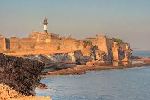
Established by the Portuguese during their governance of Diu Island, Diu Fort, positioned at the mouth of the Gulf of Cambay to the east of Diu Town is the most prominent historical monument of the union territory of Daman and Diu. Erected in the year 1535 following the ‘Treaty of Bassein’ of 1534, Diu Fort served as a stronghold that defended the island against the encroaching armies of the Mughal Emperor Humayun. Till 1546 AD, this garrison was constantly reinforced by the Portuguese. Also famed as ‘Praça de Diu’ which means ‘The Diu Fort’ in Portuguese language, this citadel is bounded by the Gujarat border to the east, the great Arabian Sea to its west and the Kolak and Kalai rivers flanking the fort towards its northern and southern boundaries.
The Diu Fort inaugurates sea routes to the bay of Cambay, Bharuch and Surat. The aerial structure of the Diu Fort majestically set up against the backdrop of the endless Arabian Sea proposes an imperious prospect to its beholders. The external wall of the fort is built along the sea line while interior wall bears bastions where guns and canons are mounted. The double moat that has been built between the outer and the inner walls functions as a strong shield of the fort. The Diu Fort has three entrances and the main entrance has an inscription carved in Portuguese. The walls, gateways, bastions, ramps and arches of the fort are in ruins today but even these remnants yield an idea of the superior military defenses planted in this fort.
The interiors of the Diu Fort are ornamented with well landscaped gardens where the pathways are bordered by the cannons. At one end of the citadel we can see a large light house. Three popular churches of Diu erected by the Portuguese back then; St. Paul’s Church, St. Thomas Church and the Church of St. Francis of Assisi are also situated within the premises of the Diu Fort. Other noteworthy monuments of the fort include old bungalows constructed in gothic style, carved wooden or stone mansions and Gangeshwar Mahadev Temple. Diu Fort, lately listed amongst the new seven wonders of Portugal built during their colonial rule, has all of a sudden come into prominence on the world tourism map.
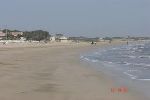
Ghoghla Beach
Ghoghla Beach, one of the six splendorous beaches of Diu Island and categorized amongst the three most impressive beaches of this sequester, is particularly reckoned for its dazzling golden sand that reflects the bright rays of the blazing sun. Ghoghla Beach, the largest beach of this region sprawls over an all embracing area of the western coastline of Indian chersonese. A potpourri of delightful ambience, enchanting surroundings and gentle milieu, the Ghoghla Beach is an ideal retreat for the admirers of nature and beauty. Moreover, this beach that offers an outstanding opportunity to indulge in the exciting water sports like surfing, parasailing, swimming and sunbathing, is a heaven for the lovers of thrilling aqua activities. A tourist complex established at the Ghoghla Beach provides all the basic amenities to the tourists and caters their best services to the visitors of Diu.
Nagoa Beach
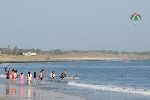
A relatively secluded beach of Diu, Nagoa Beach is located near an old fishing village of Nagoa close to Bucharwada. This peculiar beach extending over an elongated stretch of 2 kilometers is accessible by a ferry availed from the main town Diu. This ferry takes just 20 minutes to cover the distance between the Diu town and the horseshoe shaped seashore of Nagoa. Yet another alternative way of reaching Nagoa Beach from Diu town is boarding a bus from the old bus stand of Diu that is bound to Nagoa. The distance between Nagoa and Diu via road is just 7 kilometers. Nagoa Beach is a treasured escape for the peace seekers as well as for the water sports enthusiasts. Various water sport activities, swimming as well as camel and pony riding can be enjoyed here. Leisurely reposing under the palm groves and feeling the soothing cold sea breezes and sunny weather is certainly a revitalizing experience in its self. The Hokka Trees swaying to the tunes of the winds and murmuring the sweet soft medleys is an additional attraction of Nagoa Beach.
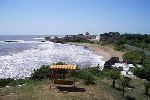
Chakrateerth Beach
Located adjacent the Jallandhar Beach of Diu, the Chakrateerth Beach is the central Beach of the Diu Island. The name of this beach has originated from a myth stating that after killing the demon king Jallandhar, Lord Vishnu had placed his ‘Sudarshan Chakra’ at this seashore. Although the beach doesn’t have any water sports, calmly relaxing on the shore and absorbing the pulchritude of the surroundings is an absolutely soothing experience. The turquoise waters of the Arabian Sea incessantly breaking against the silvery shores of the Chakrateerth Beach is undoubtedly a gorgeous site to be captured in the frame of the heart. Chakrateerth Beach is explicitly exalted for the cajoling vistas of the sunset discerned from here. The well landscaped garden of the Chakrateerth Beach further supplements its infinite natural elegance. The open air auditorium located near the Jallandhar Shrine is also a notable attraction of this beach. The open air auditorium also provides the facility of changing rooms for the visitors of the seashore. An ancient Shiva Temple is also established here. INS Khukri Memorial erected at the Chakrateerth Beach is the memento of an Indian frigate destroyed at the hands of Pakistan Navy in the Indo Pak war of 1971.
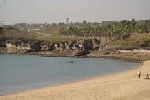
Jallandhar Beach
Jallandhar Beach, stationed just 1 kilometer from the Diu town is one of the unimpeded and calm beaches of Diu Island. Named after the notorious demon king Jallandhar who was killed by Lord Vishnu, this beach is particularly acknowledged amongst the tourists for the Jallandhar Shrine standing here. This shrine devoted to Jallandhar is built atop a nearby hill which bears a big face of the demon king. A temple dedicated to Goddess Chandrika is also erected here. Apart from that, other attractions of the Jallandhar beach are the variety of water sports, leisure activities such as sun bathing and strolling along the shorelines and enjoying in the salty waters of the Arabian Sea that draw tourists to the Jallandhar Beach of Diu.
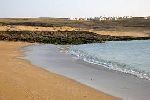
Gomtimata Beach
Gomtimata Beach, located about 25 kilometers from the main town Diu is yet another treasured jewel augmenting the glory of the rich casket of Diu. Disposed on the western extreme of Diu Island, this beach features the far-flung sweep of silvery white sand. The remote beach of Gomtimata is not suitable for swimming as it lacks deep waters. Even though, this is unquestionably a perfect destination for unwinding, strolling along the line of the Arabian Sea and enjoying the sun bathing. The creamy and snowy soft sand of Gomtimata Beach beckons myriads of tourists to come and repose in the pacifying cradle of the Mother Nature.
Sunset Point
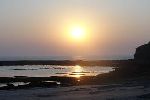
Sunset Point is a peachy little beach of Diu renowned for the spellbinding vistas of the setting sun it offers. The subduing luster of the radiating sun dissolving against the scrim of the pigmented horizon appears exceptionally theatrical at the Sunset Point. Apart from viewing the setting sun, this palm fringed beach of Sunset Point is very popular amongst the tourists for swimming.
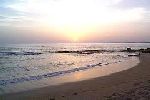
Jallandhar Shrine
Jallandhar Shrine, parked onto a lofty hillock adjoining the Jallandhar Beach of Diu Island is a shrine dedicated to the memory of the mythological Demon King Jallandhar who was killed at the hands of Lord Vishnu. This small sanctuary is surmounted with a cupola which holds a face of Jallandhar carved out of boulder. Jallandhar Shrine is placed at the distance of just 1 kilometer from Diu town. A temple dedicated to Goddess Chandrika is also located close to the Jallandhar Shrine.
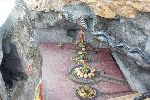
Gangeshwar Temple
The title ‘Gangeshwar’ can be explained as; the ‘Lord of Ganga’ i.e. Lord Shiva. The Gangeshwar Temple of Diu located in a village named Fudam approximately 3 kilometers away from the Diu town is a cave temple supposed to be as old as the Mahabharata period. It is said that during their exile the five Pandava brothers had paid a visit to Diu Island. It was them who enshrined the five Shiva Lingams of the Gangeshwar Temple for their daily worship. These five Shiva Lingams are installed on the rocky tableland on the seashore and the tidal waves of the Arabian Sea constantly immerse the Shiva Lingams. This is a mush visit place of Diu hailed both for its historical and religious significance.
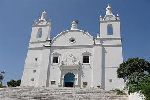
St. Thomas Church
Established in the year 1598 during the Portuguese rule, St. Thomas Church located within the premises of the Diu Fort is an ancient church of Diu Island. Designed in the Gothic style, this church has been erected on an elevated ground in the market area of the Diu Fort. The whitewashed façade of the St. Thomas Church still preserves the faded paintings and portraits dated back to the Portuguese Era. Following to its latest renovation, the Church doesn’t function as a prayer house any more, except for the one and only mass annually held on 1st November on the ‘All Saint’s Day’. Presently St. Thomas Church has been converted to a museum where apart from the local artifacts, stone sculptures of Mother Mary and Jesus Christ, shadow clocks, 400 years old petrified wood carvings, stone inscriptions of the earlier rulers, antique statues, idols, etc are exhibited. A portion of the church has been transformed to an archaeological treasure house where 400 year old wooden and marble effigies of St. Thomas and St. Benedict are placed. St. Thomas Church when illuminated in the evening presents a brilliant sight and the series of fountains planted on the walkway leading to the main entrance and embellished with flickering lights certainly enthralls its beholders.
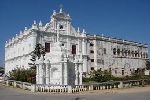
St. Paul's Church
Christened after one of the apostles of Jesus Christ, St. Paul’s Church is also stationed inside the Diu Fort at the opening of the Gulf of Cambay. Constituted over a period of ten years between 1601 AD and 1610 AD this church is fashioned after the Bom Jesus Basilica of Goa. Dedicated to Our Lady of Immaculate Conception, St. Paul’s Church, one of the three Portuguese Churches of Diu is the most celebrated, better survived and fully functioning church of this Island. Acclaimed as the unsurpassed archetype of the baroque architecture in India, the interiors of this church are decorated with intricately carved wooden work. Both the interiors as well as the frontage of the church are credited to be the most extravagant classics of adroitness amongst all the Portuguese churches built in India. The altar of this church that bears the image of the Mother Mary is carved out of one single piece of Burmese teak. Above the altar is placed a blue and white barrel vaulted nave ornamented with old paintings and statues. This church of St. Paul is regarded as an ingenious specimen of Jesuit architecture. St. Paul’s Church is one of the earliest churches in India to introduce the use of music in prayer.
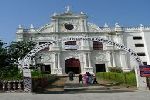
Church of St. Francis of Assisi
The Church of St. Francis of Assisi is yet another Christian place of worship harbored within the periphery of the Diu Fort. Positioned approximately 8 kilometers from the Delwada Railway Station, this church is still functional and prayer services are regularly offered here. Established in the year 1593 during the Portuguese rule, this church was the friary of the Franciscans. The cloister of the church is now converted to a hospital.
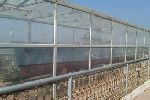
INS Khukri
INS (Indian Naval Ship) ‘Khukri’ was a warship of Indian Navy that was destroyed during the Indo Pak war of 1971. On 9th December 1971 this frigate fell victim to the cannonade of 3 torpedoes fired by a Pakistani Submarine ‘PNS Hangor’ and sank 40 nautical miles off the coast of Diu along with the crew of l8 Officers and 176 sailors. Captain Mahendra Nath Mulla, the Commanding Officer of the ‘INS Khukri’ was offered the option of saving himself by surrendering, but he kept fighting and preferred to go down in the sea with his crew rather than lose prestige and honor of Indian Navy. The brave act of Captain Mulla and his valiant crew is a shining example of unyielding guts and unconquerable spirit of the Indian Navy. Captain Mahendra Nath Mulla was awarded the Mahavir Chakra posthumously. The INS Khukri monument is established at Diu in the glorious memory of the valorous soldiers of India. It was inaugurated on 15th December 1999. INS Khukri was the only ship destroyed by the Pakistan in the Indo Pak war of 1971 when just in 48 hours Indian Navy conquered the port of Karachi.
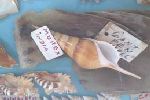
Sea Shell Museum
Sea Shell Museum of Diu is the first museum of Asia that houses the maximum number of sea shells. It displays the personal collection of Captain Fulbari who was a sailor and spent most of the time of his life collecting sea shells. This also happens to be the first museum in the World where sea shells of various sizes are displayed in the magnifying glasses. The Sea Shell Museum of Diu boasts of its extensive collection of 2500 to 3000 sea shells such as scorpion, spider, abalone and cockle. Moreover, the museum also houses reading materials on the history of the shells. Located near the Nagoa Beach of Diu to the east of Diu Airport, this museum is a must visit place of Diu Island.
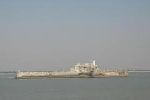
Fortim Do Mar
‘Fortim Do Mar’, popularly known as the ‘Fortress of Panikotha’ is an alpine citadel built right at the mouth of a creek in the Arabian Sea. Perched about one nautical mile from the Diu jetty this fortress, formed out of stones harbors a light house and a small chapel of Our Lady of the Sea. Bounded by the fathomless Arabian Sea from all the sides, Fortim Do Mar creates a compelling contour seen from any angle. Designed in the shape of a ship, this fortress is believed to have been linked with land by an under water tunnel in olden days. To reach Fortim Do Mar from Diu one can avail the feasible ferry service. Fortim Do Mar is also used as a set in a popular Bollywood movie named ‘Qayamat’.
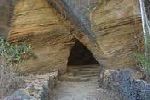
Naida Caves
The Naida Caves of Diu is an extensive network of tunnels with square shaped steps which is situated outside the main wall of the Diu Fort. The locals of Diu believe that these caves were punctured by the Portuguese to obtain building materials for the Diu Fort from there. The Naida Caves are located about 8 kilometers from the Delwada Railway Station and they can also be easily accessed by the road.
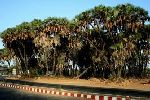
Hokka Trees
Hokka Trees is a botanical species scientifically known by the name ‘Hyphaene Indica’. This happens to be the only Indian horticultural specie of African origin. Hokka Trees were brought to Diu by the Portuguese and they are not found anywhere in India except for Diu. Diu Island is abundant with Hokka Trees and the fruits of Hokka Trees are edible and have medicinal properties.
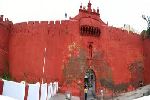
Zampa Gateway
Zampa Gateway, constructed during the Middle Ages is an extrusive landmark of Diu Island. Featuring the intricate carvings of angels, lions and a priest, this gateway is also celebrated for its beautiful artificial waterfalls. Adjacent to this gateway is placed a chapel which was constructed in 1702 AD.


